Bikepacking and heading out to enjoy nature on two wheels are more popular than ever before. We went in search of a bike that offers the perfect combination of long-distance suitability, versatility and baggage hauling ability. After hundreds of kilometres and numerous nights outdoors, will it be a gravel bike at the top of the podium or will the full-suspension mountain bike surprise us all?
Table of content: What is in this test?
- The test field
- Who tested the bikes?
- The most important characteristics
- Our findings
- Why we don’t test in the laboratory
- The best bikepacking bike on test
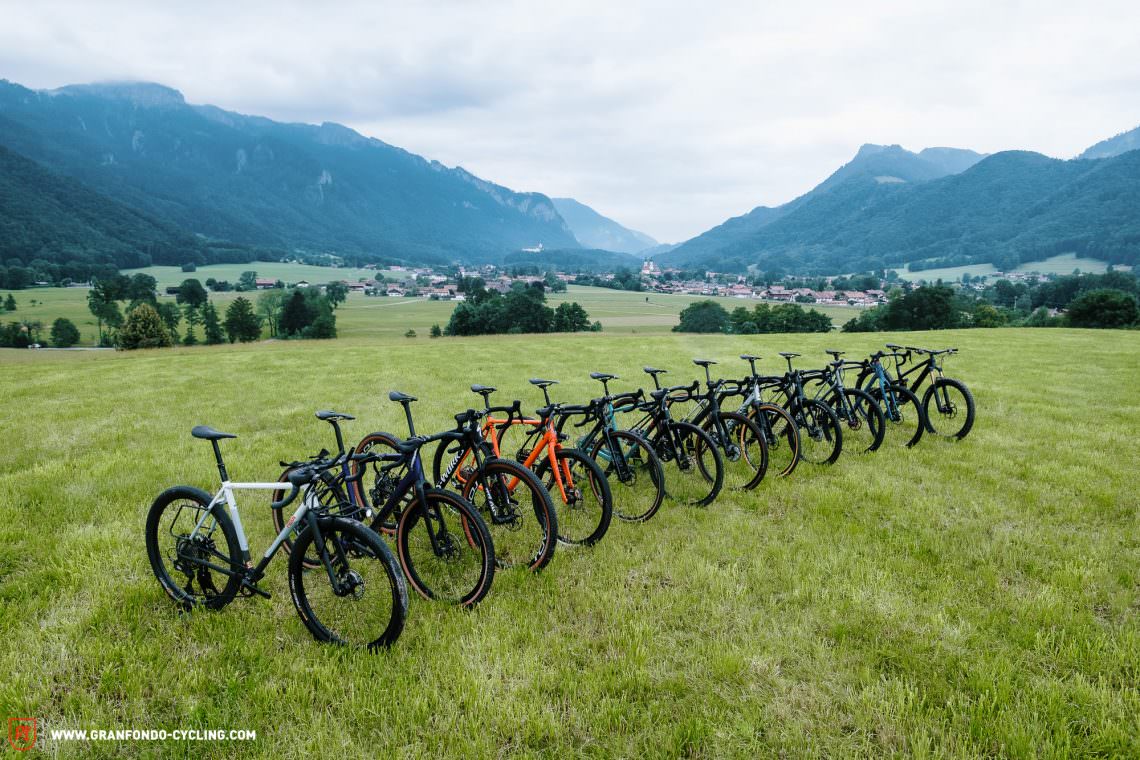
Stuck in a routine, we run on the spot in the hamster wheel of our lives, day in, day out. Feeling trapped and overwhelmed with our obligations, so stressed we’re constantly on the verge of burning out. When was the last time we looked at the starry night sky and let our thoughts wander away from work and the big city, allowing our minds to drift free? How long has it been since we were able to switch off completely and clear our heads of all the things that constantly demand our attention? It’s time to escape this life-sucking vortex. Get out into nature and experience something new. Forget your troubles somewhere in the foliage of the woods. Experience the adventures that you normally only read about or see on the TV screen, in your own body with all of your senses. Fill your mind with great memories to draw on when you’re back in the hamster wheel. Recharge your batteries so you can go to work or be with your family full of energy and fully present. Everyone benefits from it. So, if not now, when?



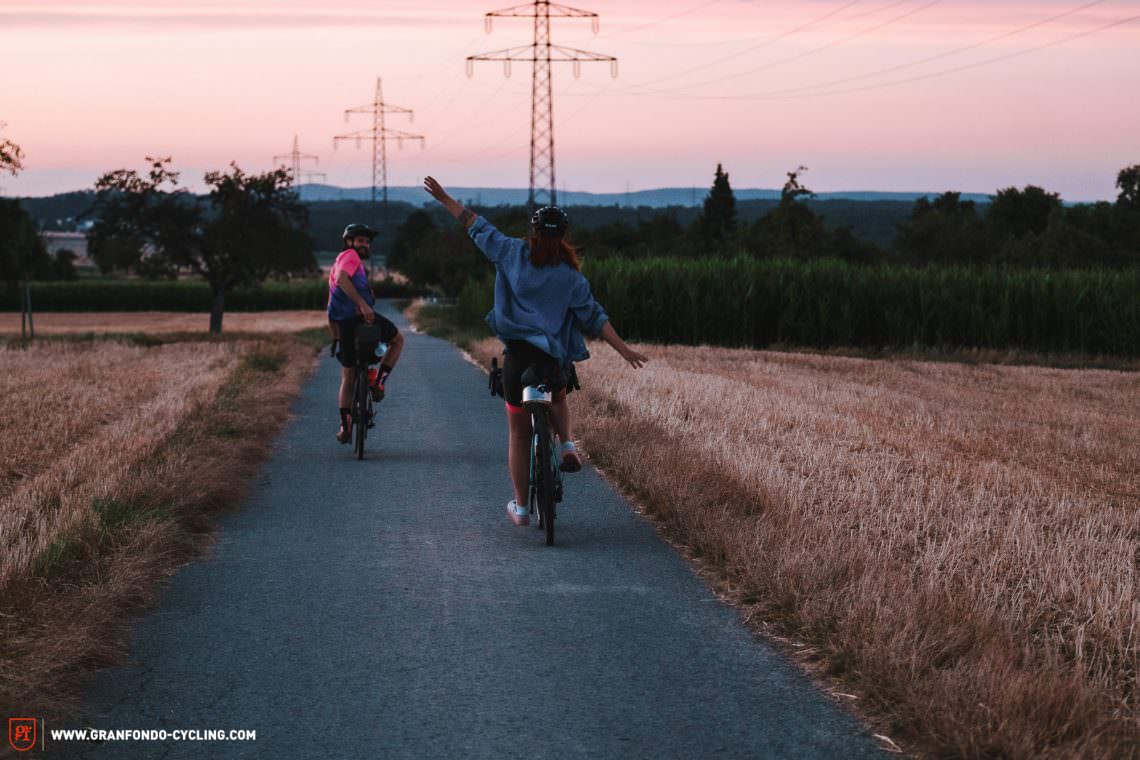
Bikepacking despite a busy schedule?
If you’re thinking you haven’t got time for this, you’re wrong! It doesn’t have to be a two-week bikepacking trip through Scandinavia or North Africa. Simply taking your bike, sleeping bag and sleeping mat with you to work in the morning and spending a night outdoors after work counts too. Bikepacking is not an exclusive extreme sport for professionals but a perfectly logical addition to an active lifestyle. Sit on the saddle, leave the hustle and bustle of the big city behind and embrace the chirping of the birds and the crickets – your mental and physical baggage will dissolve away with every passing kilometre and settle in the dust behind you. After a night spent in a sleeping bag with nothing more than a few shooting stars between you and the moon, you head back into the office the following day. You’ll be surprised how much calmer and more serenely you’re able to tackle upcoming tasks and what little influence ill-tempered work colleagues will have on you. You are not only looking for the best bike for bikepacking, but also want to know everything about gear, route planning and accommodation? Then click here for our detailed Bikepacking 101!

In principle, every bike can be used for bikepacking. Strap on some bags and you’re off!

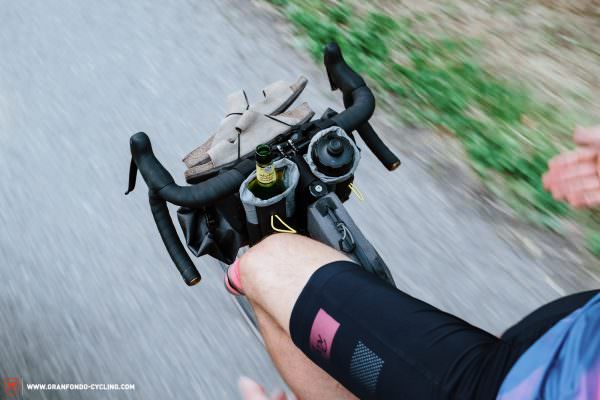
In our opinion, a bicycle is the best tool to leave everyday life behind and experience the outdoors. There is a clear trend towards domestic holidays, or at least staying on your own continent. There’s no doubt that bikepacking trips in Southeast Asia remain alluring and the Rocky Mountains will always attract visitors with their untouched nature and breathtaking landscapes. However, take a look around and you’ll quickly notice that there are some incredibly worthwhile holiday destinations waiting for you much closer to home. At the moment, we can’t fly around the world as we used to be able to for years anyway. Do you really need one long-haul flight every year to go on vacation or can a short journey not do the trick, allowing you to experience at least as much? A bikepacking bike is the best tool for this. Whether you take your car to the starting point, head out of the city by train or start directly from your front door, your bike will never let you down. It is one of the most ecologically sustainable ways of travelling and will take you to almost any point on your destination bucket list. So what are you waiting for?
Which bikes did we test?
Ok, one thing in advance: in principle, any bike can be a bikepacking bike. Strap some bags on and you’re off! However, some models are more suitable for bikepacking than others. Nowadays the selection of bikes is bigger than ever and it is difficult to keep track of the number of categories available. We also gave it a lot of thought, racking our brains about which bike would make for the perfect bikepacking bike. Would it be the likes of a gravel bike, without suspension, with drop handlebars and numerous mounting points, or would a full-suspension mountain bike make for the best compromise with its comfort and off-road capability? We didn’t take any shortcuts in our mission to find out, testing twelve different bikes on Germany’s best gravel and asphalt roads as well as singletrack – loaded up with bags, of course.
| Bike | Price | Weight | Transmission | Wheelset |
|---|---|---|---|---|
| Bombtrack Hook 2 (Click for review) | € 1,999 | 10.76 kg | 40 (11-42) | 700x37C |
| Canyon Grail AL 7.0 SL (Click for review) | € 1,749 | 9.24 kg | 42 (10-42) | 700x40C |
| Fern Chuck Explorer* (Click for review) | € 10,999 | 10.22 kg | 38 (10-51) | 650x56B |
| Marin Headlands 2 (Click for review) | € 2,899 | 9.81 kg | 42 (10-42) | 700x40C |
| Mason Bokeh GRX (Click for review) | € 4,400 | 9.94 kg | 48/31 (11-34) | 650x48B |
| MERIDA SILEX+ 8000-E (Click for review) | € 3,999 | 8.87 kg | 40 (11-42) | 650x45B |
| RONDO BOGAN (Click for review) | € 1,999 | 11.45 kg | 42 (11-42) | 700x53C |
| ROSE BACKROAD AXS Mullet Build (Click for review) | € 3,699 | 9.12 kg | 40 (10-50) | 650x47B |
| Salsa Cutthroat GRX 600 (Click for review) | € 3,399 | 10.90 kg | 46/30 (11-34) | 700x56C |
| Specialized Diverge Comp Carbon (Click for review) |
€ 3,999</td | 9.36 kg | 48/31 (11-34) | 700x38C |
| Specialized S-Works Epic HT AXS* (Click for review) | € 2,999** | 8.95 kg | 32 (10-50) | 700x58C |
| Trek Fuel EX 9.9 XTR Project One (Click for review) | € 8,899 | 13.18 kg | 32 (10-51) | 700x66C |
| *Custom-Bike **Frameset | Ø 10.15 kg |
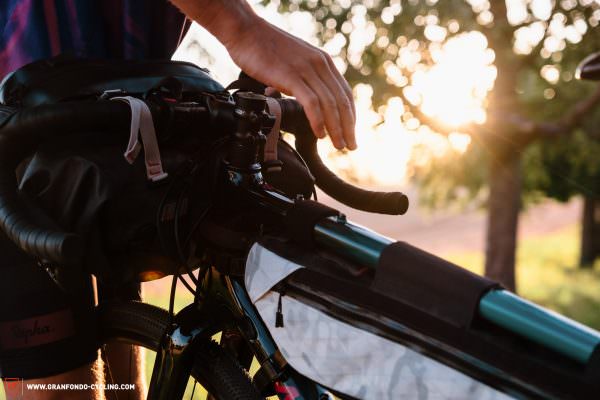
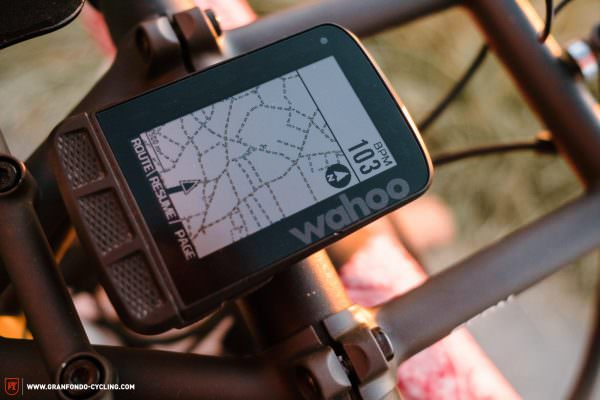
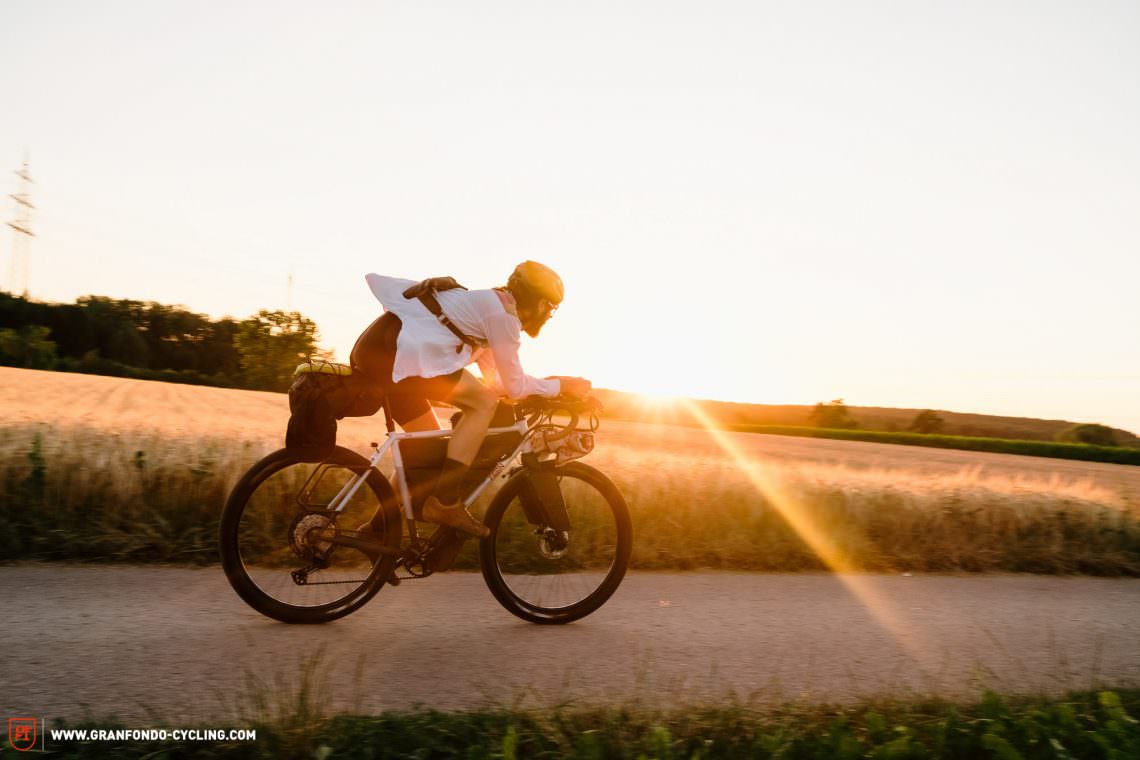
The sudden rush of people going out to buy bicycles has thwarted our editorial plans, as we had actually planned to include more bikepacking-specific bikes in this group test. We would have loved to review models such as the Moots Baxter, the Bombtrack Hook EXT/EXT-C, the Niner RLT 9 Steel or the 2020 Ritchey Outback. Unfortunately, none of them were available at the time of our test. As a result, the test field shifted more towards gravel bikes, though lots of these, such as the Canyon Grail, the ROSE BACKROAD or the Specialized Diverge, still offer great all-round features. The two most important prerequisites for being part of this bikepacking bike group test were mounting points for racks and cages and being able to cope with the added weight of luggage. With bikepacking bikes, the more eyelets there are on the frame and fork the better. You can’t have too many! While assessing the bikes, it was important for us to find out how well they handle a full load at high speeds. That’s not to say we raced them and the aim of our excursions was never to get to the destination as quickly as possible. However, if you head down a long descent after a strenuous climb and the handling is stable enough for you to stay off the brakes even with the bike fully loaded, you’ll be able to enjoy the ride that much more.
The more eyelets there are on the frame and fork the better.
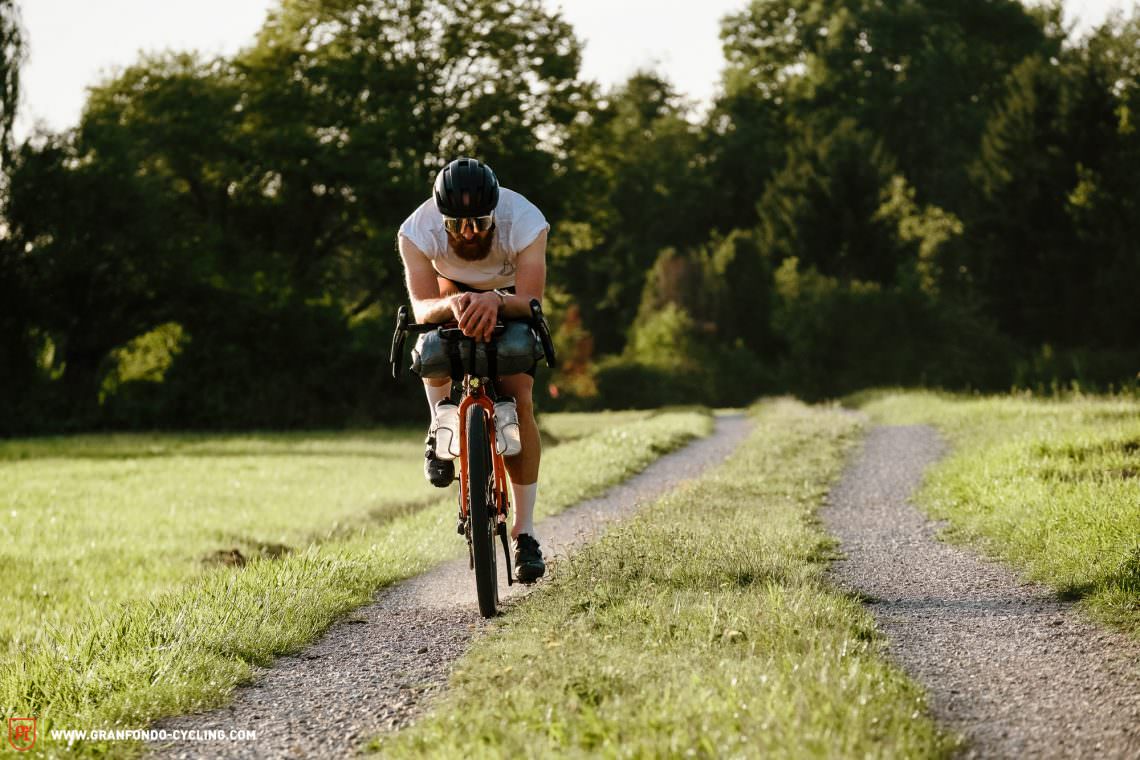
We included two mountain bikes in our test as a reference and wanted to see how they would perform as bikepacking bikes. The Specialized EPIC comes with a suspension fork, yet is lighter than many of the gravel bikes in the test field. The Trek Fuel EX is a tried and tested full-suspension mountain bike that has previously scored for its comfort and versatility in our sister magazine ENDURO, making it an excellent representative of full-suspension bikes for long days in the saddle. And if we’re being totally honest, we just felt like shredding through the woods and riding mountain bikes again. 😉 The price ranges from € 1,749 to over € 10,000 but the majority of the test field hovers around € 3,500. However, as you will see later, price wasn’t a determining factor when choosing the bikes for the test. Unfortunately, we also encountered models whose frames deserve higher quality components but are only available up to a certain price point. All bikes were tested as you’re able to buy them from the manufacturer or dealer, with the exception of the slightly modified Specialized EPIC hardtail and the completely custom-built Fern. On ordering the latter it will be completely customised according to your wants and needs, including the geometry.

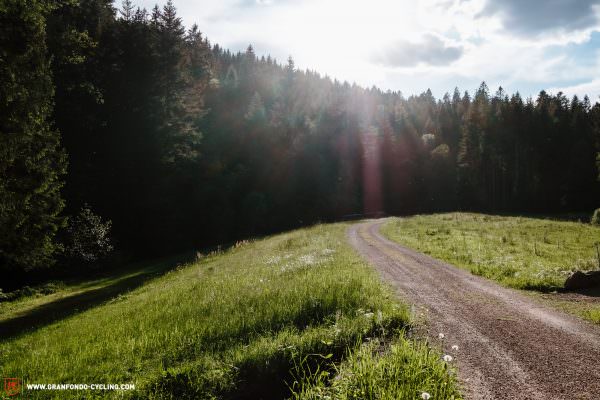
Where did we test?
To see what they’re capable of, we had to find a test track close to our headquarters that offers a variety of conditions and also represents a challenge for the bikepacking bikes on test. We found what we were looking for near our Alpine ENDURO office at the foothills of the Alps and created a test loop that consists of 35% asphalt, 50% gravel and 15% easy single track, including gravel and mountain roads and thus offering a good representation of what you’re likely to encounter on a typical bikepacking trip. We were lucky enough to have different weather conditions and rode on dry terrain as well as wet gravel and damp forest floors. We also went on several multi-day bikepacking trips with different setups in the Alpine region between Germany and Austria, in the areas surrounding Stuttgart, the Black Forest and in the Allgäu.
Who tested the bikes?
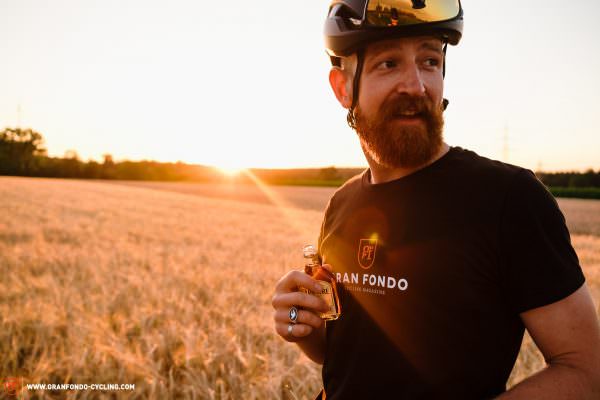
GRAN FONDO editor-in-chief, Gravel-Aficionado
After thousands of kilometres on a wide variety of gravel bikes, I was very excited to see what a bike specially developed for bikepacking would be like. Is it an unnecessary bike category or does it make sense to differentiate it from gravel bikes? So far, gravel bikes have always been sufficient in carrying my minimalist equipment, so why change? For me, the bike’s handling comes first. If it scores there, the sky’s the limit.
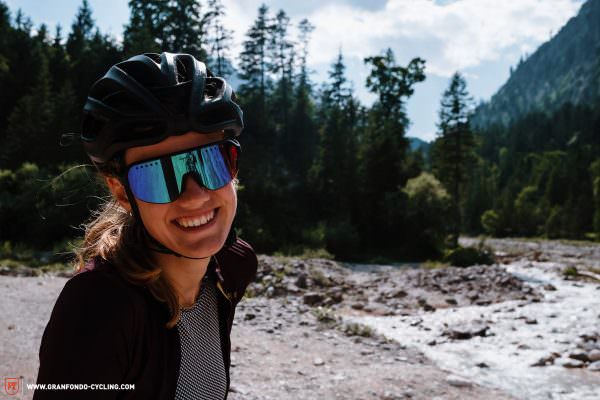
landscape architect, cardio expert, aesthete
As a newcomer to the scene, bikepacking captivated me. It allows me to combine several hobbies: exercise, nature, travel and adventure, and all of that with my boyfriend, whom I see far too little of day to day. I’m not that interested in the latest technology. It’s more important for me to have a lightweight rig. I won’t say no to bags that match the colour of my bike for a great looking setup either.

software developer, hot boy of cycling
For me, cycling has always been a means to an end, to cover a distance from A to B or to keep myself fit. Voluntarily wandering through the woods for several days without a fixed destination and sleeping on a camping mat? Unthinkable! However, I’ve started to see things differently after my first bikepacking trip. Sure, a hotel room is still four times as comfortable as sleeping on the forest floor but I’ve never felt the same feeling of freedom as I did during this adventure!
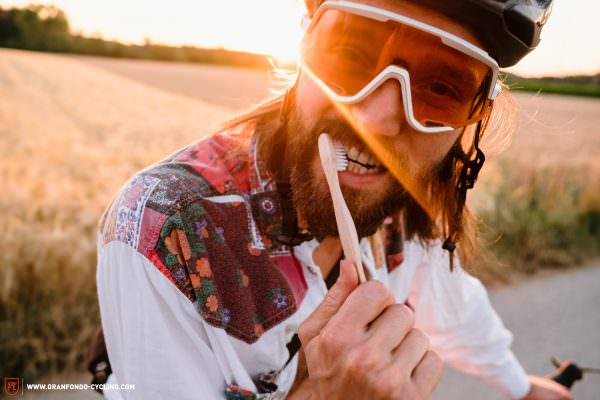
eMTB editor-in-chief, former downhill racer
We used to spend a lot of time outdoors in my old Jeep and enjoyed being able to reach almost any destination that seemed exciting to us. However, recently it was time to get rid of the fuel guzzler – it had become too unreliable and prone to breaking down. The most obvious alternative? A bike of course! Fuel consumption? Zero. Breakdowns? Not worth mentioning and all repairable with your own two hands. For me, the perfect bikepacking bike has to be reliable and tough. If I spot an opportunity to catch air, the bike has to be capable of dealing with it!
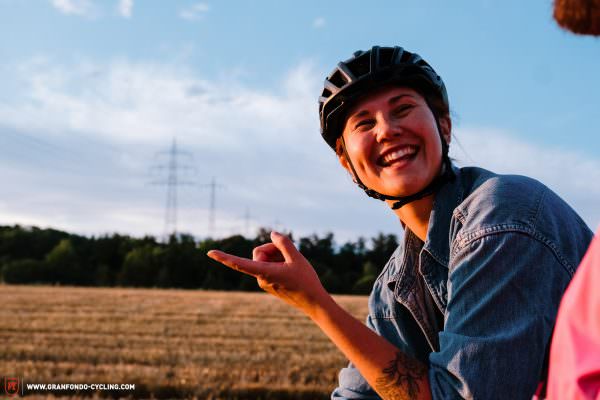
lead management program designer, dog mum
Without my dog Leo? Then without me. Whenever my boyfriend plans one of his totally chaotic trips, my dog is always included. It doesn’t matter whether it’s on foot, by car or bike. When we’re bikepacking, we’re extremely flexible, we take every day as it comes and Leo is happy to run through meadows all day anyway. I feel most comfortable on a bike with a relaxed riding position and enough mounting points for Leo and my things.
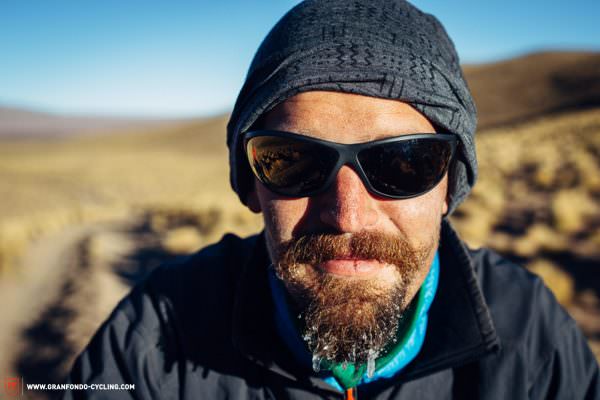
graphic designer, started bikepacking before it was hip
For me, bikepacking is a way of life. Far away from civilisation, nature is the most beautiful and exciting retreat I can imagine. After numerous bikepacking adventures, including a month-long trip through Bolivia, I now know exactly what I want from a bikepacking bike: long-distance comfort, reliability and sufficient mounting points for luggage racks and the obligatory bottle of single malt whisky.
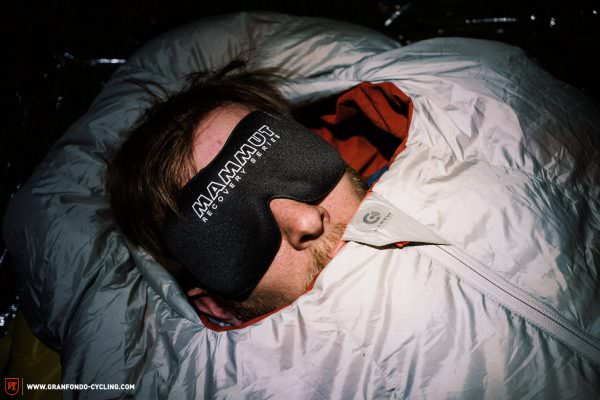
GRAN FONDO editor, family man
After my very first bikepacking adventure many years ago in Scandinavia and Germany, I was stoked by it as a form of travel, as well as the bikes and equipment. Since then, I’ve been trying to optimise my setup every year. The bikepacking boom and the numerous innovations it has brought with it are great! Since a future bikepacker has started running around at home, my time has become scarcer. For me, overnighters are the perfect opportunity for maximum returns with a minimum of time invested.
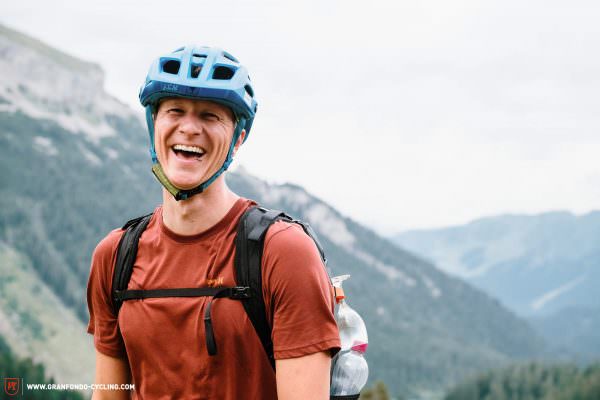
excavator engineer, adventurer
When I’m not boarding during winter or surfing by the sea in the summer, you’ll find me shredding the Allgäu mountains on my bike. Until now, I’ve only ever considered making a trip with a backpack on my mountain bike. Riding through deserts and over roots with narrow tires? No thanks! With the trend of ever wider tires, more comfort and dropper posts on bikes with drop handlebars, my enduro bike has started collecting dust in the basement.
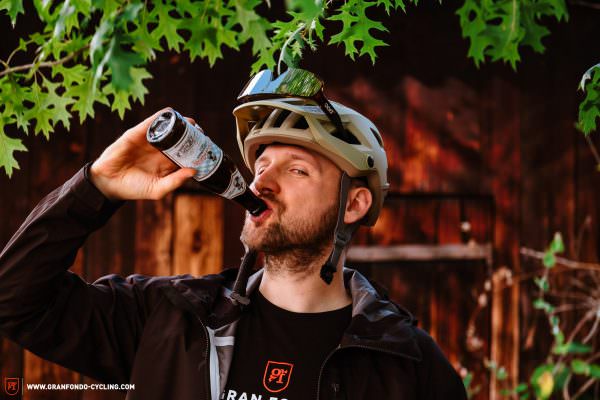
GRAN FONDO junior editor, foodie
There’s only one way for me to ride a bike: full throttle. It doesn’t matter to me whether I’m on a mountain, road or gravel bike. Speed is safe – and fun! The perfect bikepacking bike should be able to corner aggressively and accelerate efficiently, whether on asphalt or gravel. If it also has space for a large frame bag in which I can stash my camping stove and a luxurious dinner, all the better.
How did we test?
To make our test as realistic as possible, we loaded each bike up with 7 kg of luggage. We think this corresponds to the average payload that you should be carrying for any trip longer than a night, though this will vary slightly depending on the time of year and climate. We distributed the luggage according to the possibilities afforded by the respective bike, meaning not every bike was packed the same, though the weight was distributed evenly. We mounted three main bags on each bike: on the handlebar, saddle and frame. To keep the test fair and comparable, each bike was ridden extensively in advance by one of the test riders and then all bikes were compared back to back.
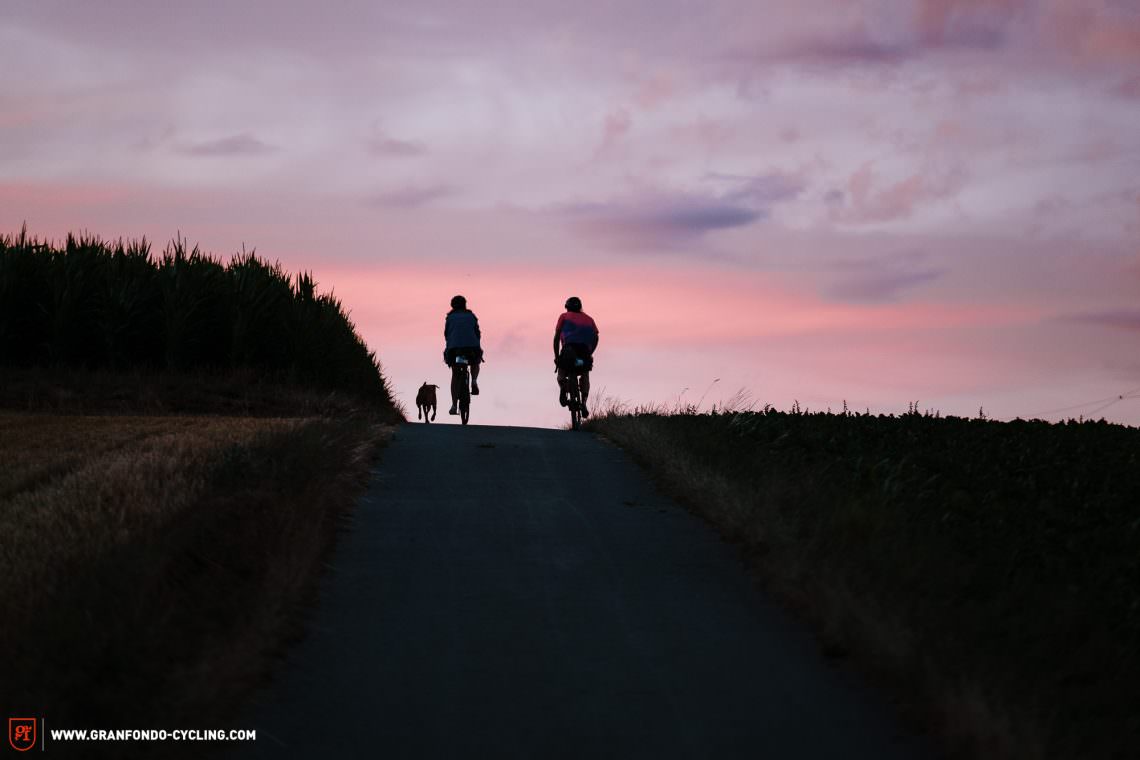

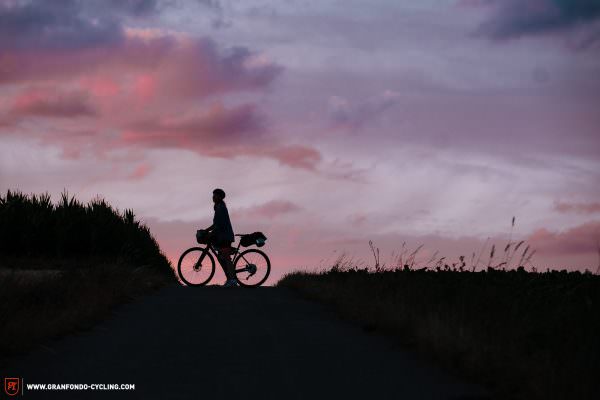
What does it come down to? The most important characteristics of a bikepacking bike
Bikepacking trips are as multifaceted as the bikes and the people who ride them. Many of us only have enough time for a few short overnighters or weekend trips per year, while others sit on their bikes for several weeks every summer and cross entire continents. Accordingly, the list of requirements is long and as usual, we went in search of the holy grail, the one bikepacking bike quiver. The variety of potentially suitable bikes on the market can be both a curse and a blessing. On the one hand, everyone should be able to find the perfect bikepacking bike for their respective needs. On the other hand, it becomes almost impossible to see the forest for the trees and decide on one of the numerous options or categories.
Bikepacking trips are as multifaceted as the bikes and the people who ride them.
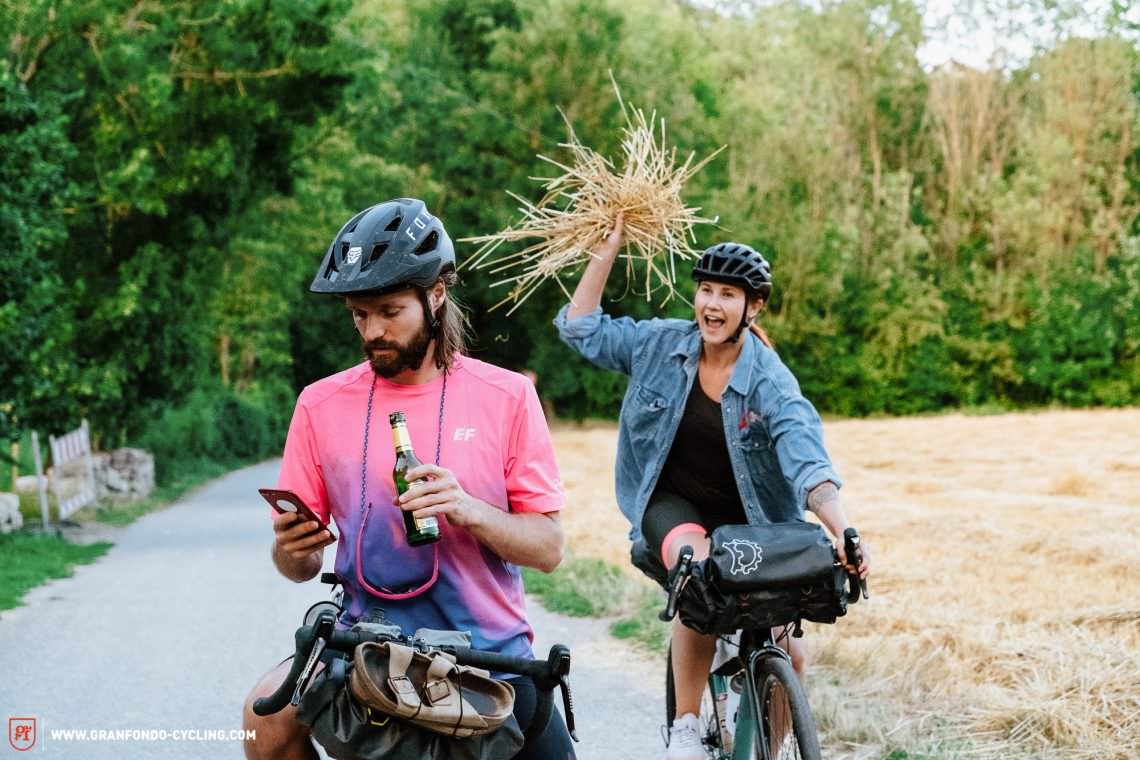
To do justice to the group test and, ideally, to actually find the holy grail we were looking for, we took time to consider which criteria the perfect bike would have to meet for long-lasting bikepacking fun. They all have one thing in common. Whether it’s short local weekend trips or several months adventuring across entire continents, every bikepacking excursion requires a bike that is suitable for covering long distances and therefore it has to offer a lot of comfort. Besides being very versatile, it should also feature up-to-date technology with sensible components and useful frame features. Here’s a detailed list of all the things we paid the most attention to.
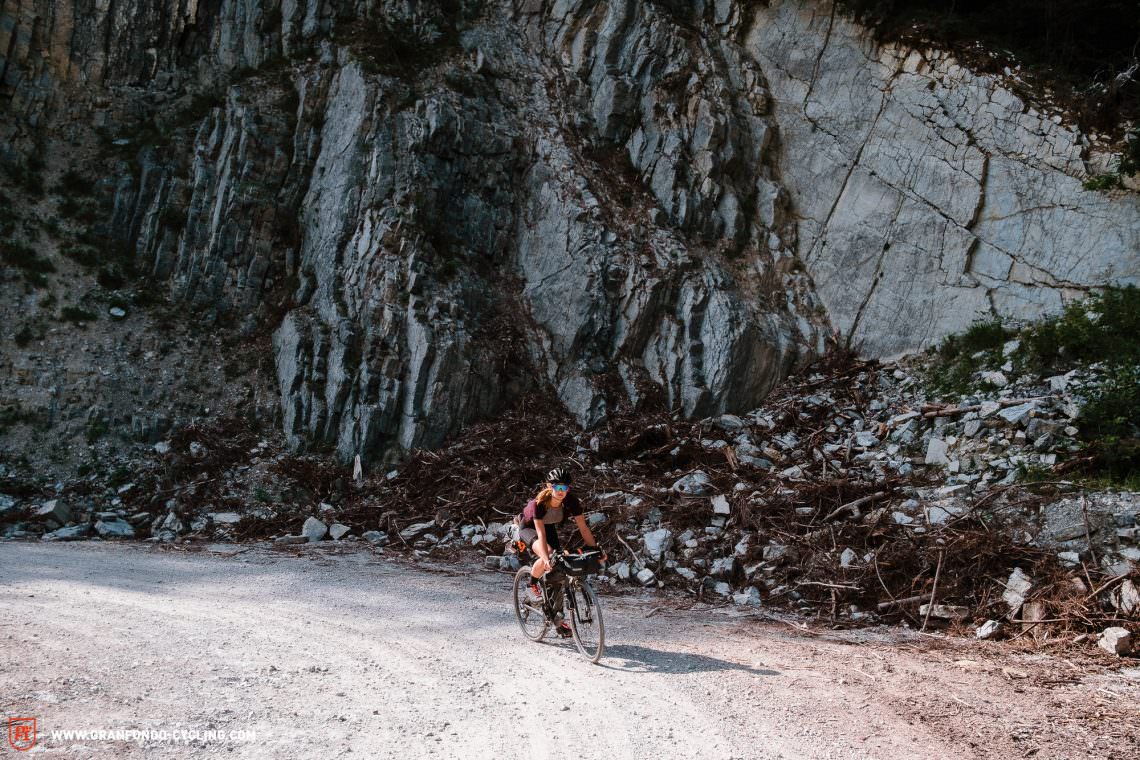
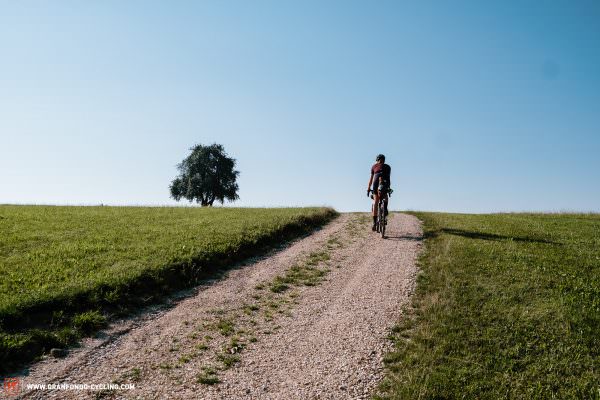
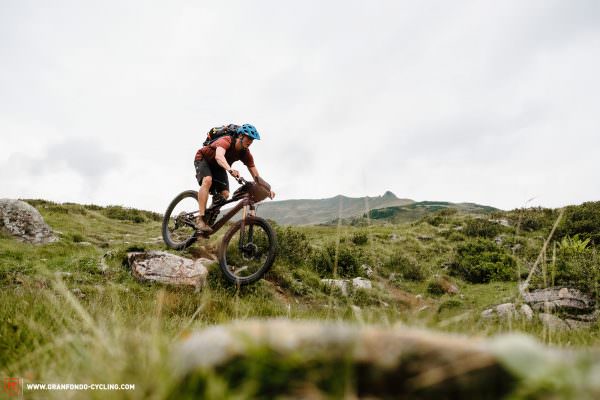
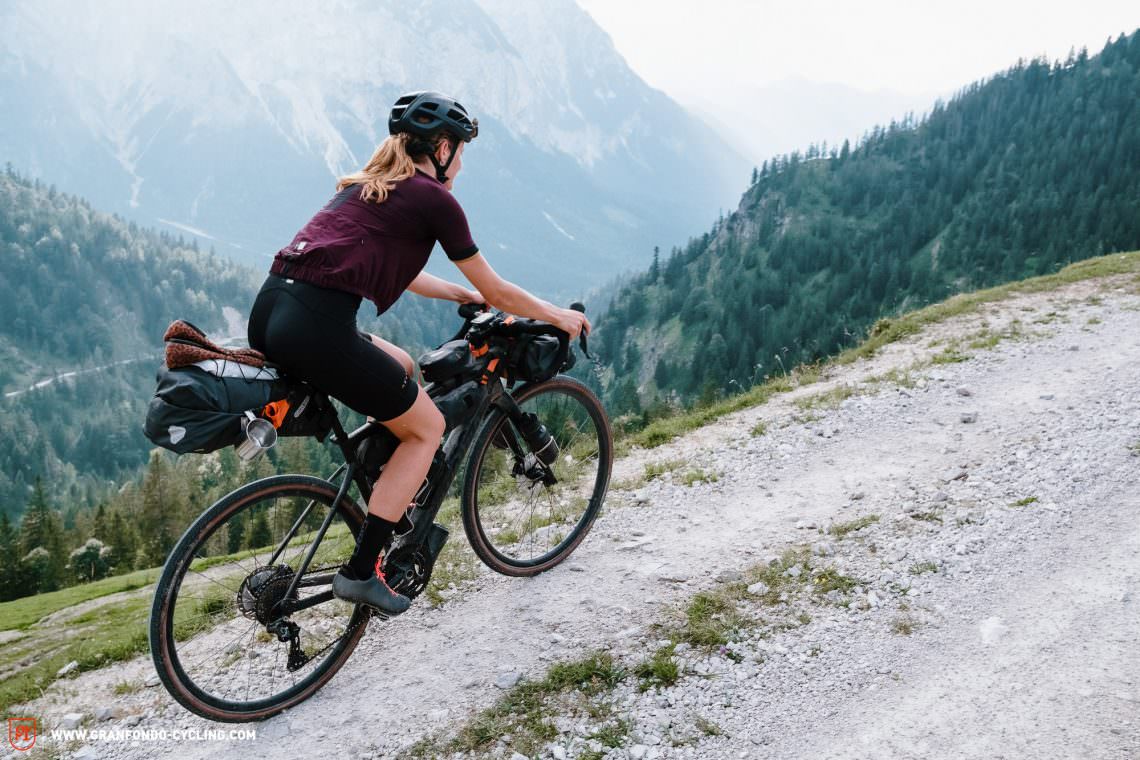
Long-distance suitability
Long-distance suitability is a critical parameter in assessing a bikepacking bike. Ideally, the bikes will get ridden for several days or even weeks at a time. The number of kilometres ridden is less relevant and it’s more about the sheer hours in the saddle. Comfort determines whether you can carry on riding your bike without pain after whole days on gravel roads or whether you have to gingerly crawl into your sleeping bag on the first evening. Contact points have the most immediate effect on comfort, but everything from the frame, wheelset, tires and seat post also play an important role. As usual, we didn’t consider the saddle in our evaluations as comfort here is hugely dependent on rider preference. A bikepacking bike should have balanced geometry for easy handling and always remain composed without feeling cumbersome. Besides instilling you with confidence, which depends heavily on the bike’s handling, comfort, grip and rolling resistance of the tires are other important criteria to consider when evaluating long-distance suitability since efficiency, speed and acceleration do play crucial roles here, too. How easily can you bring the bike up to speed and how well does the bike carry that momentum? Is it efficient enough to maintain speed with moderate effort? As you can see, long-distance suitability is an important and complex equation. The perfect bike for long distances and long, successive days in the saddle offers a perfect balance of compliance and cushioning, with handling that is good-natured and composed while efficiently converting your pedal strokes into propulsion.
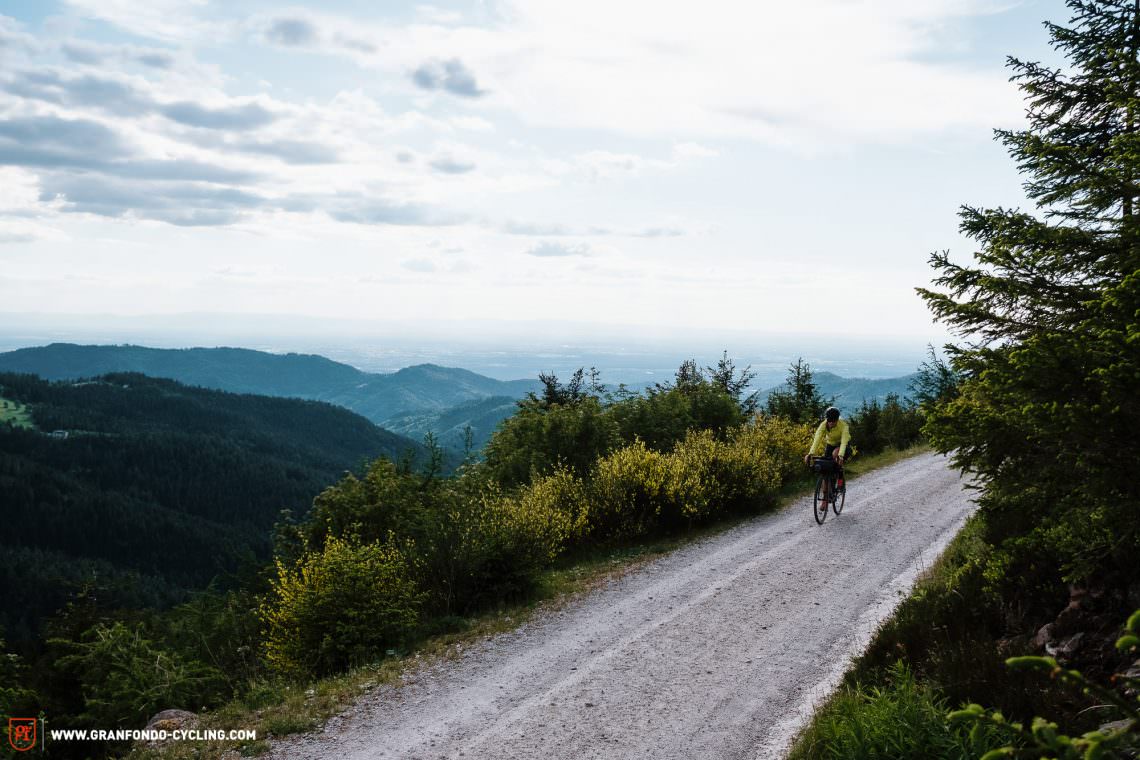
Versatility
Compared to bikes from other categories such as dedicated time trial or aero bikes which were developed for very specific scenarios, a bikepacking bike has to be a lot more versatile. Whether on dusty gravel roads, at the foot of the alps with steep climbs and rough descents or miles of winding asphalt, the ideal bikepacking bike has to perform convincingly in every situation. Therefore, we put each bike through its paces and checked what it excels at and what it doesn’t. We always kept versatility in mind, asking ourselves whether the bikes only work with a full load or whether they can also be used for daily commuting or a day trip without luggage. For us, the ideal bikepacking bike needs to perform convincingly in a wide range of scenarios.
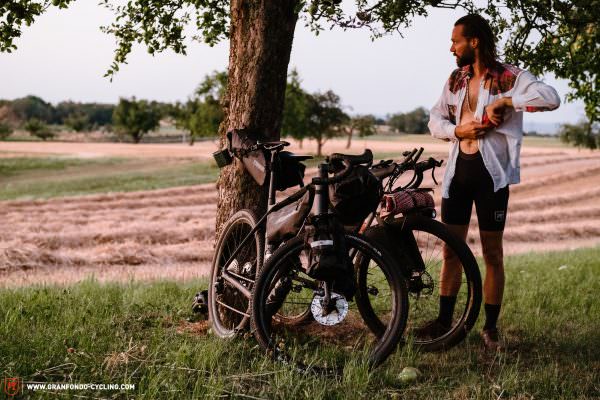

Tech
Tech encompasses two criteria for us: sensible components suited to the application and features that set the frame and fork apart. To perform on flat terrain as well as with a load on rough and steep gravel roads, the gear ratios of the drivetrain have to be appropriate. Neither a road bike groupset with a 53 t hero chainring nor a 1x groupset with a tiny cassette make sense here. To always stay in control even on long descents with the additional weight of your luggage, a bikepacking bike should be equipped with sufficiently large brake rotors. Another vital aspect is the vibration damping and geometry of the frame, along with a good seat post and ergonomic handlebars for sufficient compliance and a comfortable position. The perfect bikepacking tire should offer a compromise between good grip in all weather conditions and on all surfaces, low rolling resistance and sufficient puncture protection. We were pleasantly surprised by the fact that we didn’t suffer a single flat tire during the entire test! Along with the frame itself, the fork should also have sufficient mounting points. Besides bags and bottle cages, this will allow you to attach luggage racks and mudguards if required. Additional handles, where you can grab the frame, can be very helpful if you’ve got to carry your bike, which, unfortunately, can’t always be avoided even on a well-planned route. Clean and clever cable routing doesn’t only look beautiful, it also makes attaching a handlebar and frame bag a lot easier. The bike should have generous tire clearances to be compatible with wide tires that generate a lot of grip and comfort, preferably 700 x 45C or wider. The best bike in the test not only has to be well specced but also offer lots of bolt-on points and clever frame details.
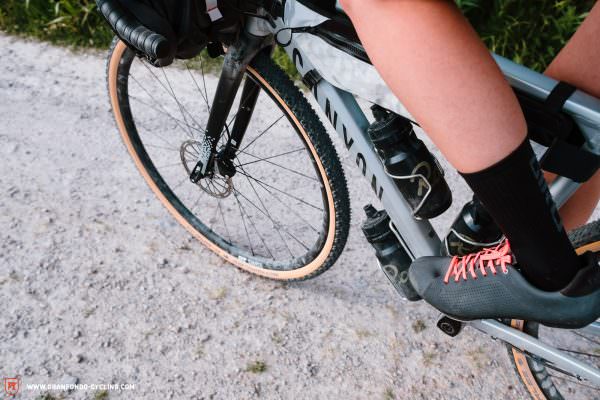
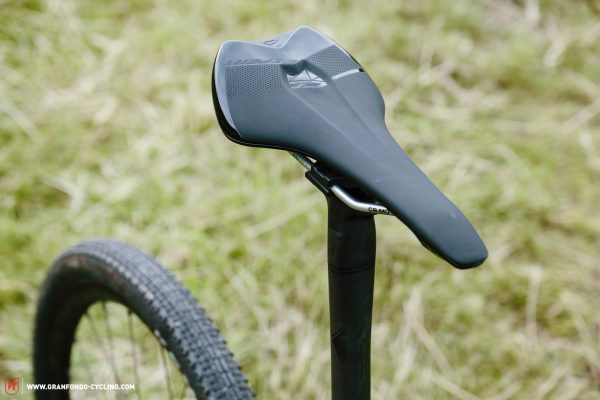
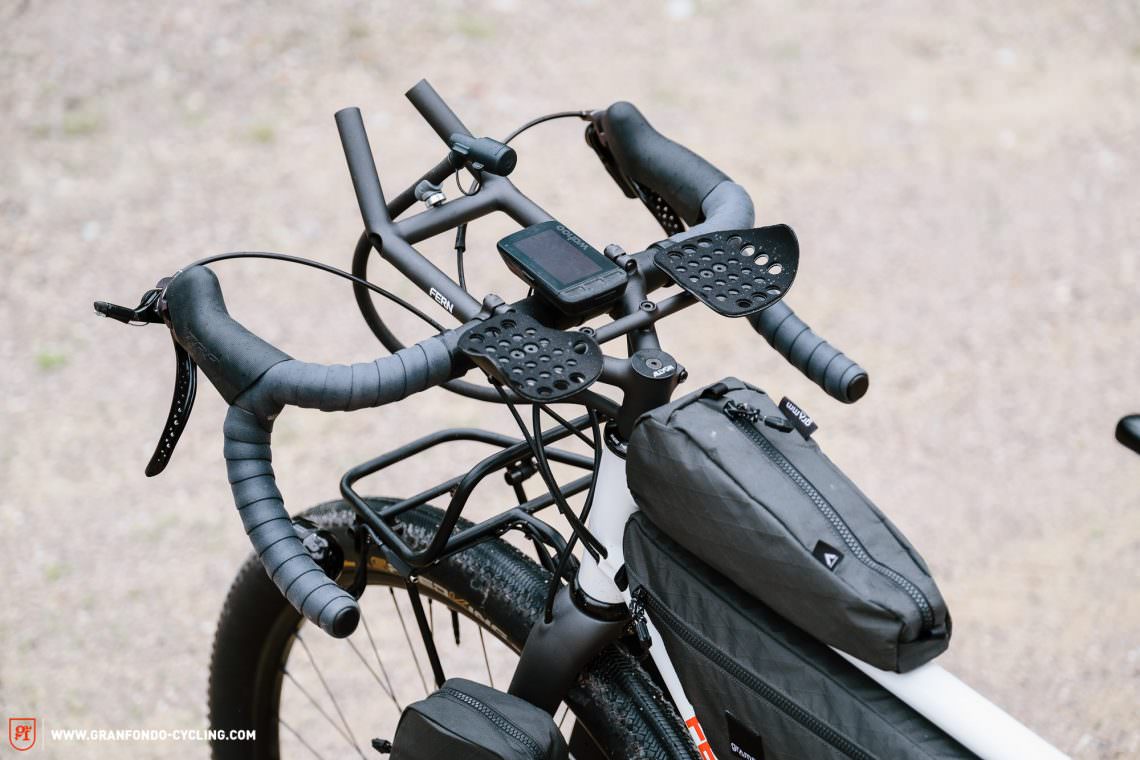
The most important findings
Our review of the best bikepacking bikes answered many of our questions and taught us a lot. The list of requirements for the perfect bikepacking vehicle is long and it is important to pay attention to the components and features that are relevant to you before buying. Read on to find out what these are and where there’s room for improvement: The 6 most important findings from our bikepacking bike group test – What to consider before buying.
The tops and flops of our group test
Often, it’s the details that make all the difference: seamless integration, good ergonomics, and well-chosen components. We’ve listed all of the group test’s tops and flops for you below.
Tops

Every component on the ROSE has been carefully selected. We were especially impressed with the ergonomics and comfort of the cockpit.
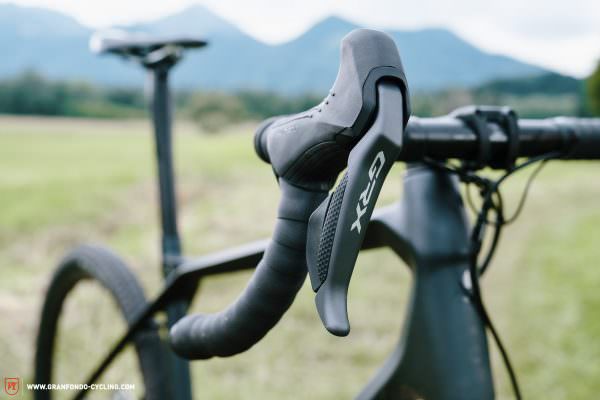
Electronic shifting makes a lot of sense on a bikepacking bike. You can even use a power bank to charge the Shimano GRX Di2 drivetrain while riding.
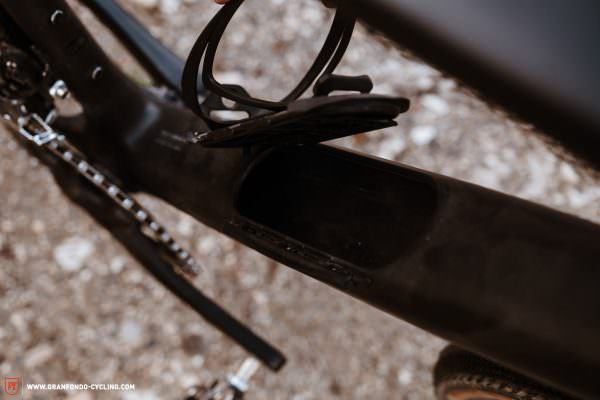
You can store all of the small bits that you don’t need to access that often in the down tube of the Specialized Diverge. We used it to store our CO2 cartridges and spare tubes.
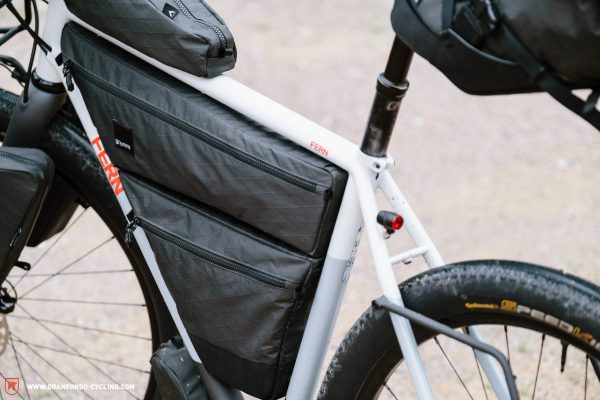
GRAMM work in close cooperation with FERN to match every detail of the bags to the bike. It’s by far the cleanest and most versatile overall package on test.
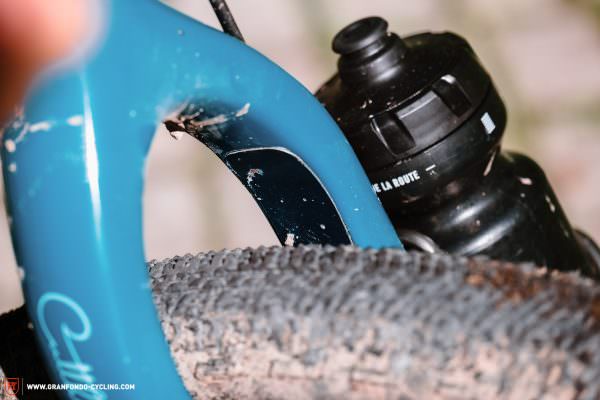
Despite running wide 29” tires, the Salsa still has enough clearance for even wider tires or mud.
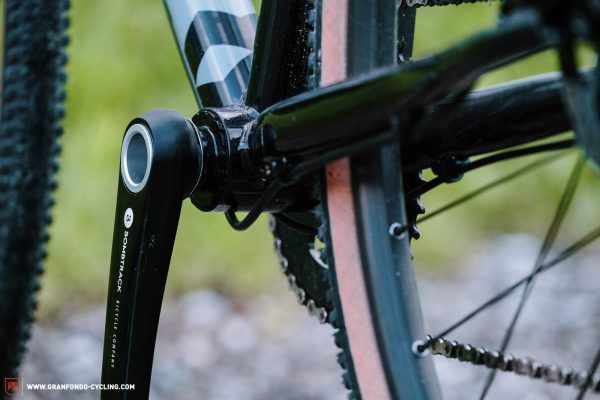
The BB shell of the Bombtrack is threaded and compatible with the T47 standard.
Flops
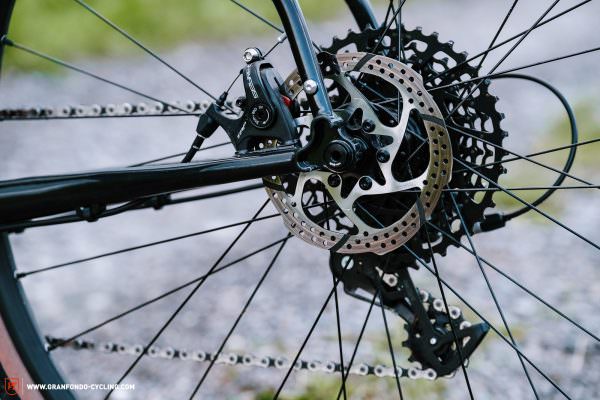
There’s no place for 140 mm rotors on a bikepacking bike. Mechanical brakes such as those on the Bombtrack stand to benefit the most from bigger rotors.
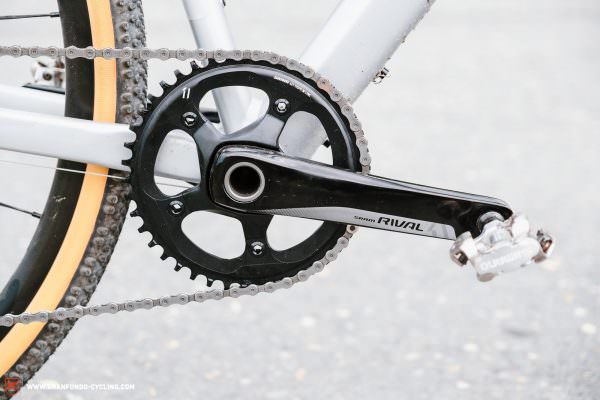
The last thing you need on a steep climb with all of your luggage and tired legs on the third day of your bikepacking trip is an overly large chainring. The 42 t model on the Canyon is much too big for the gear range offered by the cassette.
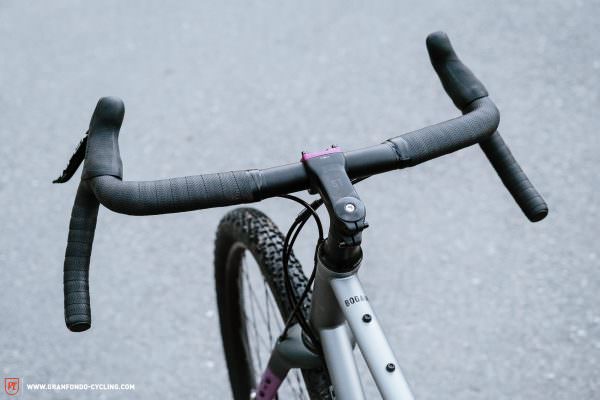
Besides the tires, the components on the RONDO don’t do justice to the performance of the frameset. You’ll have to upgrade almost everything before heading out on your first trip.
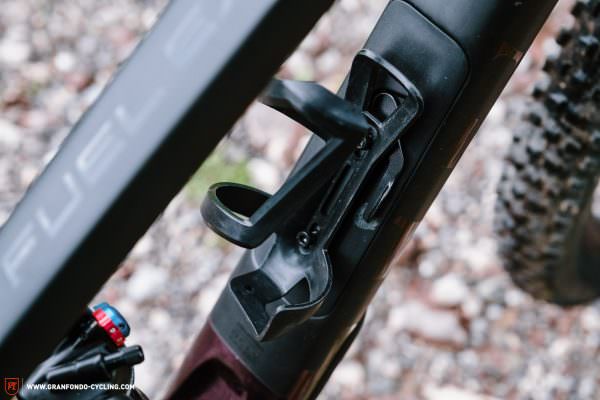
The Trek’s shock takes up a lot of room inside the already small front triangle. You’ll be hard-pressed to find a sensibly sized frame bag that fits. At least you’ve got a bit of added storage space for small bits under the bottle cage.

The MERIDA has so many features that make it an excellent bikepacking bike. Unfortunately, the slow-rolling tires kept it from the podium.
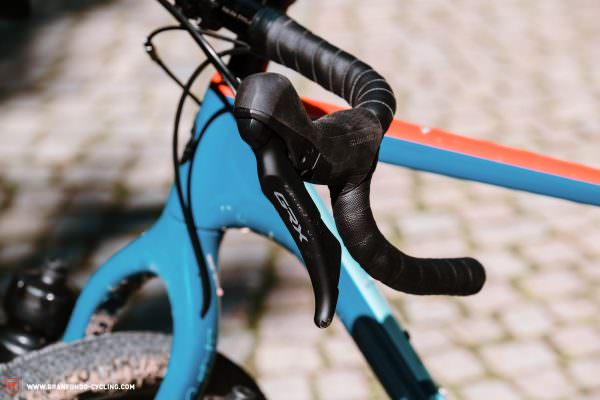
The coating on the Shimano GRX shift and brake levers quickly wears off with the rigours of day to day bikepacking use, making the bike look older than it is.
Why we don’t test bikepacking bikes in the laboratory
Laboratory tests are great in isolation. The results obtained give you numbers that you can print in black ink on white paper which we can use to easily score products. We could create a stylish graph for everyone to see and read why bike A received top marks in terms of comfort but only scored average points for stiffness. The problem isn’t just that every laboratory takes different measurements but that this approach doesn’t allow you to view or understand the bicycle as a whole, complete system. With a bikepacking bike you’ve got other parameters besides bottom bracket stiffness or the weight of the wheelset that are impossible to measure, including factors such as the previously mentioned long-distance suitability, the frame’s features and the bike’s versatility.

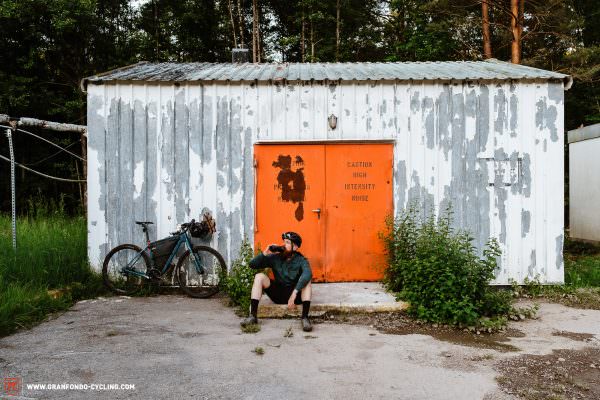

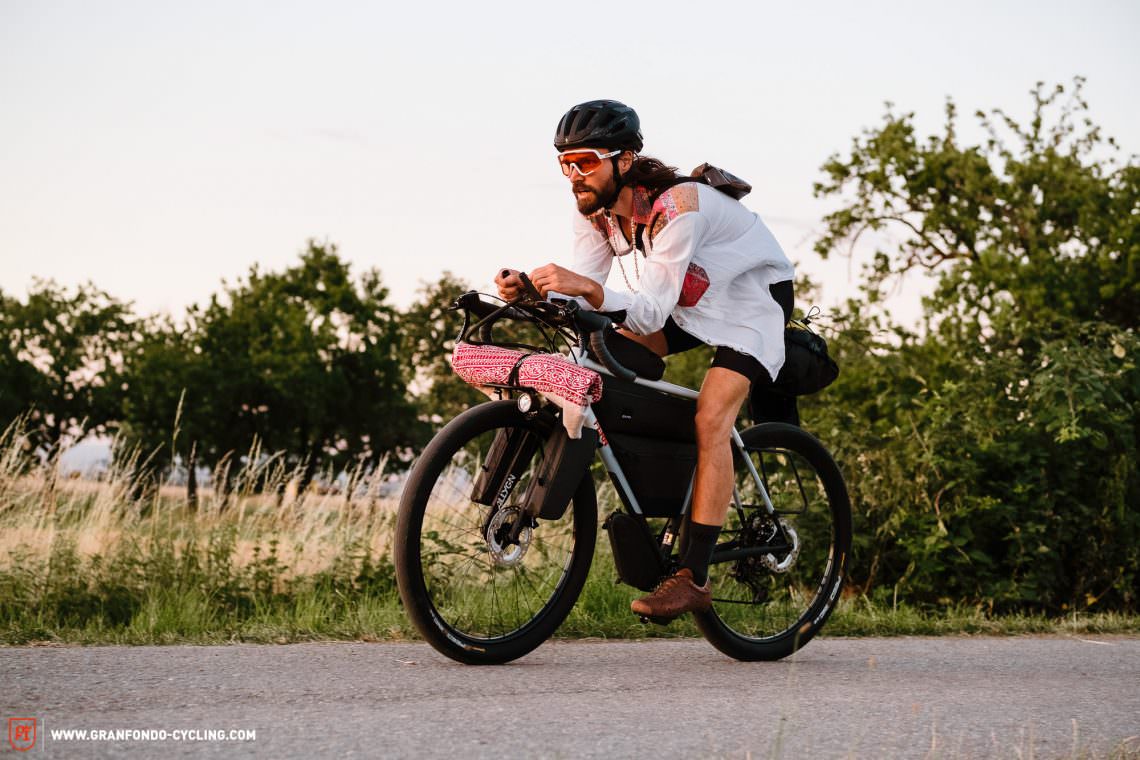
Bikepacking bikes are our loyal companions, taking us out into nature, on real adventures. In contrast to measurable parameters such as weight, a bike’s adventure capability can’t be determined in a laboratory. How tiring or comfortable a bike is over long distances can only be experienced subjectively, in your own body out on the road or gravel path. Every rider is built differently, with different preferences and also their own peculiarities in terms of riding position, desired components and other details that make the perfect bike perfect for them. The wobbling mass of a tired person and their luggage on a naturally moving bike can neither be simulated nor reproduced in a laboratory, which is why we tried to make as comprehensive an assessment of the bikes as possible with a diverse field of test riders, to be able to make statements and recommendations that our readers can truly rely on. In the end, we found a clear winner!
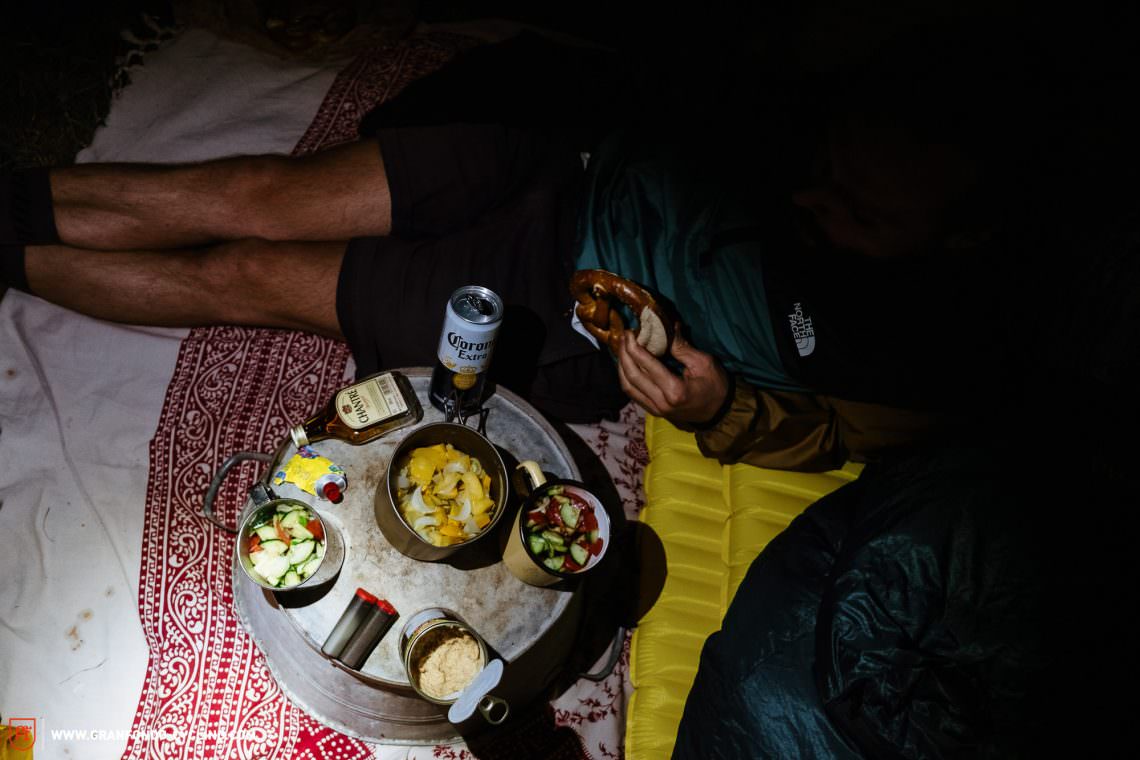
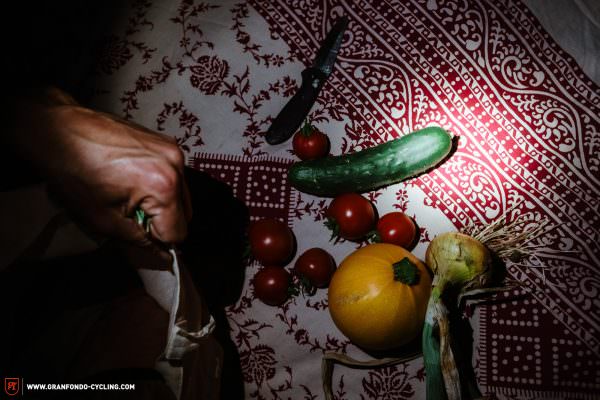

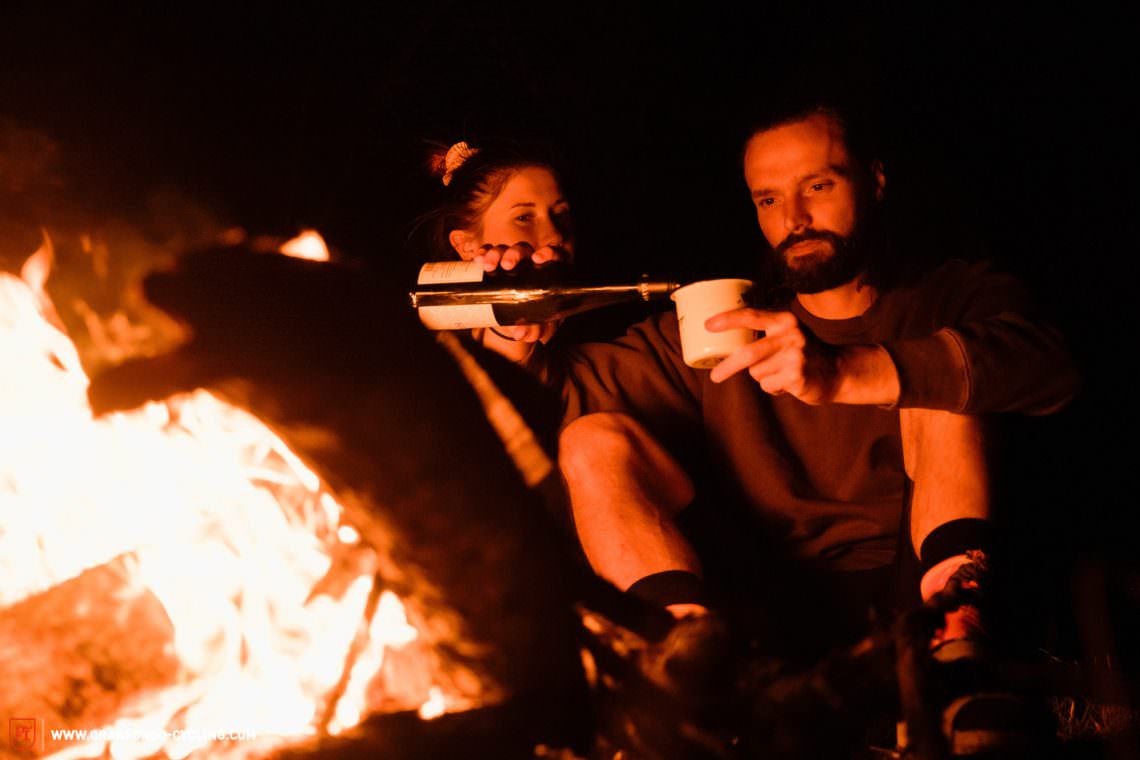
The best bikepacking bike of 2020 – Salsa Cutthroat GRX 600
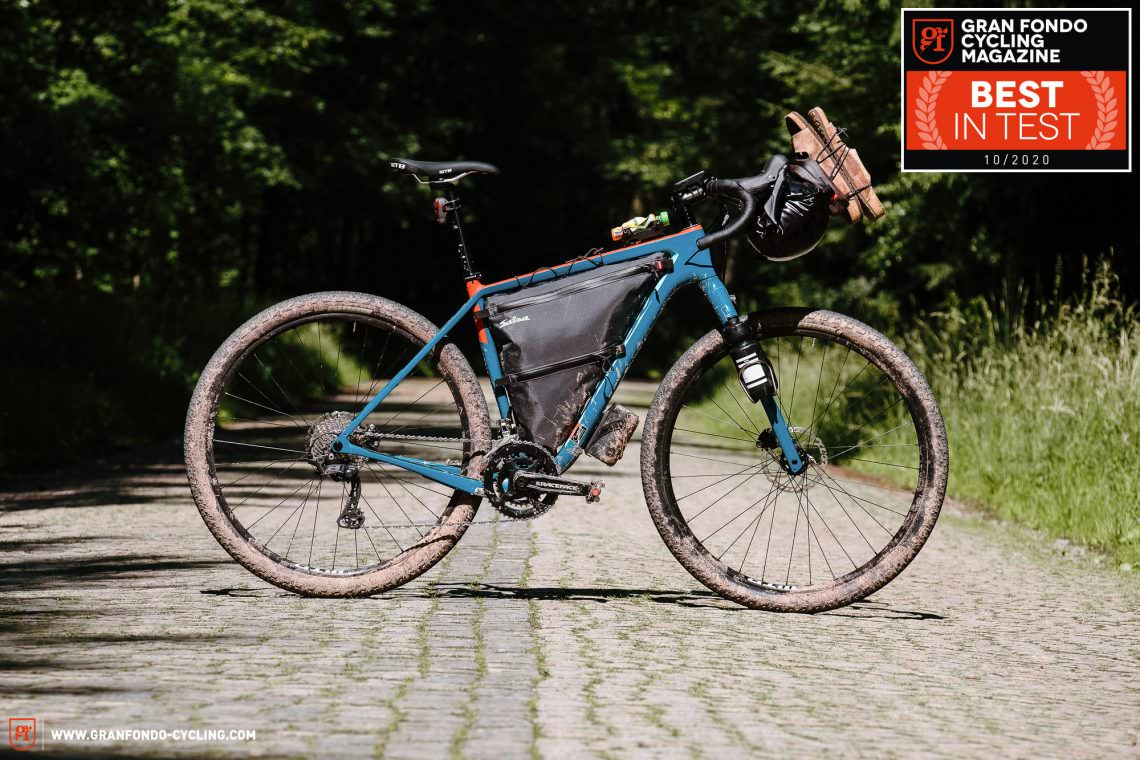
With its composed, predictable and balanced handling and high level of comfort, the Salsa Cutthroat quickly conquered the hearts of our test riders. The generous tire clearances and the frame’s clever features prove that the designers gave a lot of thought to how this bike can be optimised for the needs of bikepackers. Its excellent vibration damping and the almost infinite number of mounting options for luggage and gear make it the perfect bikepacking bike!
Our Best Buy on review – Bombtrack Hook 2
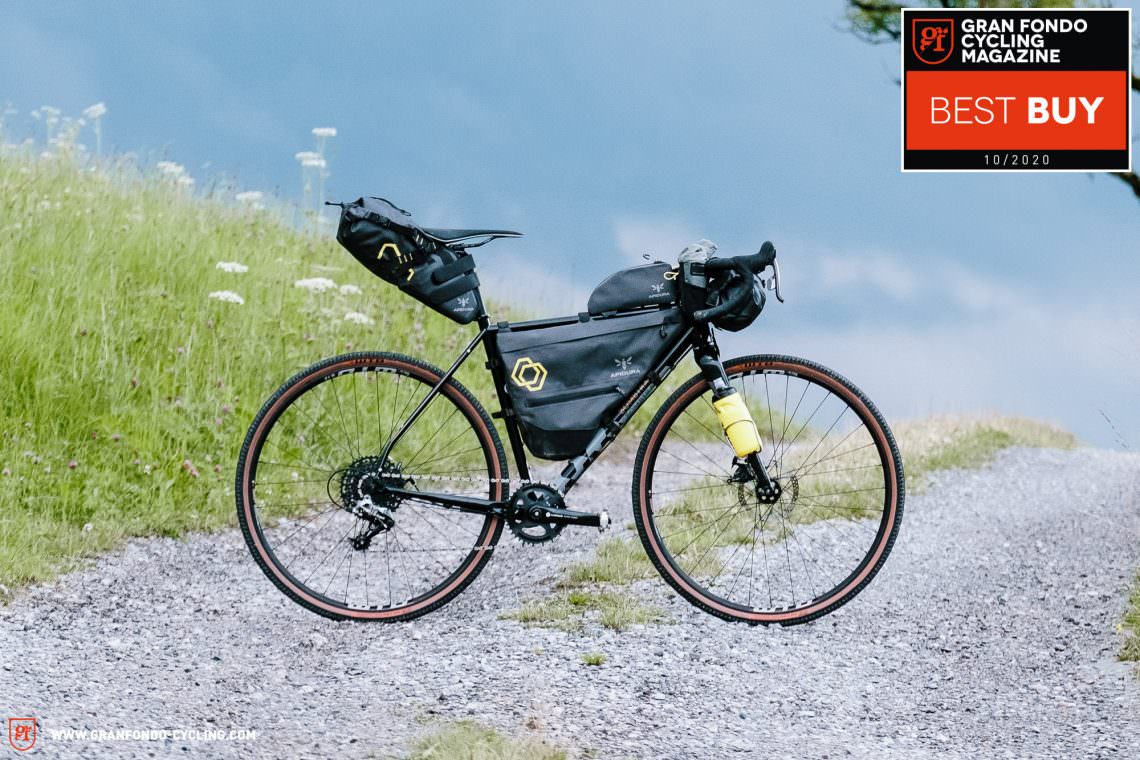
The Bombtrack Hook 2 surprised us: despite the comparatively narrow tires, it offers a pleasant level of comfort, especially on compact surfaces and asphalt. If you’re going to avoid roots anyway, you get balanced handling, extremely robust components and multiple mounting points at a very fair price. The Hook 2 cuts a fine figure on the way to work as well as on short overnighters or several week-long bikepacking trips – our Best Buy!
Other exciting bikepacking bikes
The ROSE BACKROAD is a versatile and well-specced gravel bike. Due to its riding position and direct and lively handling, it is aimed more at competitive bikepackers or experienced gravel riders who only occasionally travel with luggage.
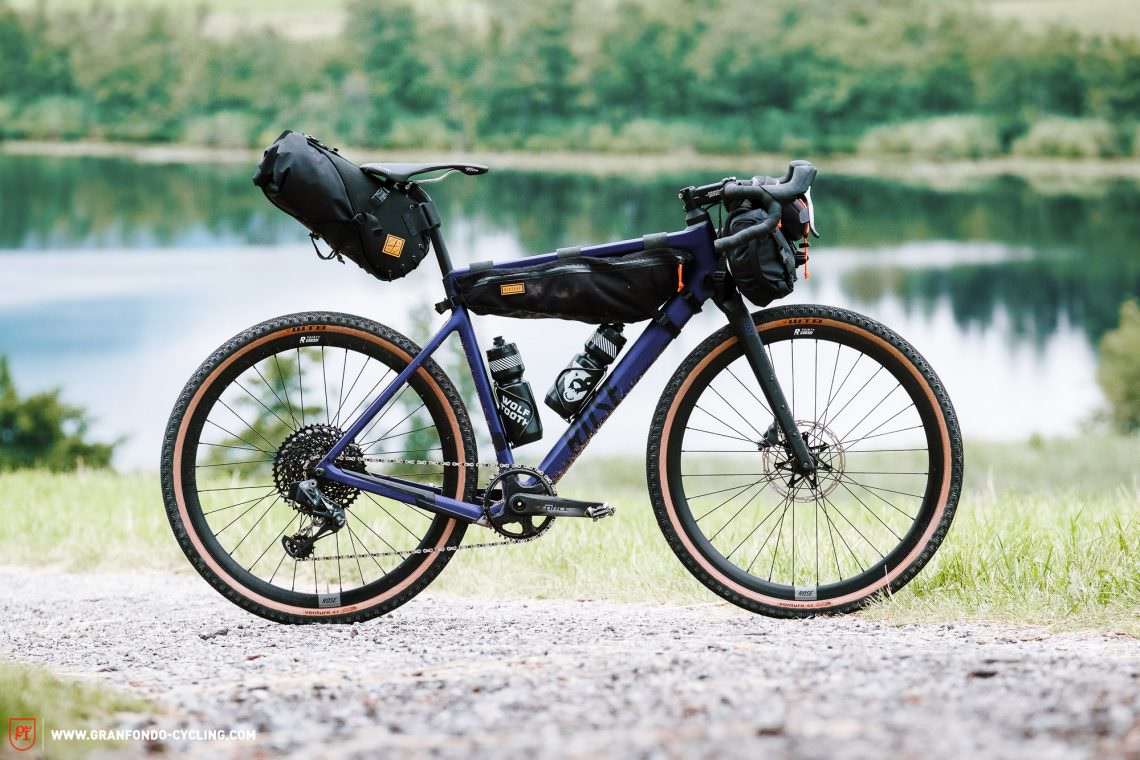
As light as a thoroughbred road bike and as comfortable as a mountain bike – the Specialized Epic hardtail combines the best of both worlds and turns out to be a bikepacking race bike. However, due to its ultra-light construction, you do have to treat it carefully. The EPIC definitely isn’t a low-maintenance bike that you carelessly can lean against a rock.
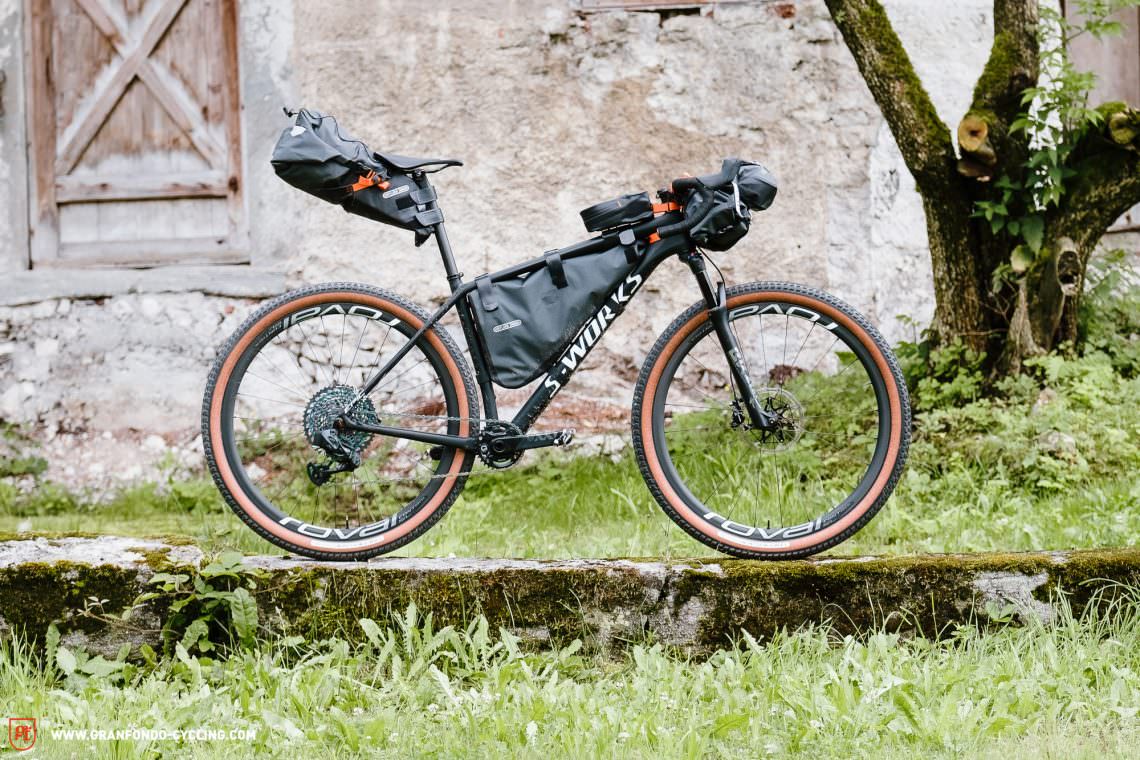
The Fern Chuck Explorer is the Brad Pitt of bikepacking bikes. It’s completely custom built and styled down to the smallest detail – the tailor-made bags are just one of many highlights. With a FERN you can let your imagination run free and you’ll be dreamingly longingly about this bike before it’s ready. 😉

Mister long-distance-comfort: The MERIDA SILEX+ 8000-E gravel bike performs better than any other bike in the test on long distances. With its balanced handling and plenty of space for bags, it’s perfect for epic journeys through entire continents. However, due to the high rolling resistance of its tires, the stock bike rolls rather slowly.
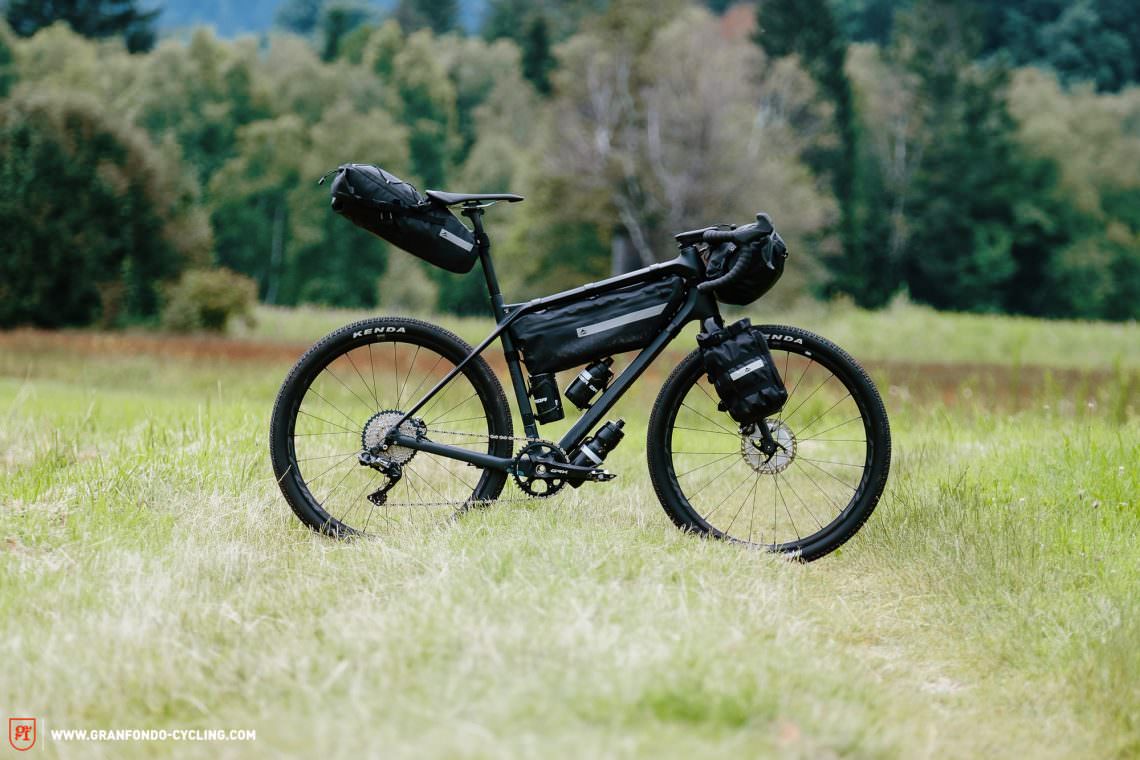
The losers of the group test
Unfortunately we have to count the Rondo Bogan among the losers of the test, despite an excellent frameset. The frame offered a lot of comfort, an almost infinite number of mounting points and very balanced handling. Unfortunately, the components are at least three leagues below the frame’s potential and, except for the tires, you would have to upgrade every one of them before the first bikepacking adventure can begin. Please Rondo, give the Bogan the components it deserves!
The Canyon Grail is a very good introduction to the world of gravel, offering easy handling and quick acceleration on compact surfaces. The spec sounds too good to be true for the asking price. However, the biggest problem with this bike and what makes it unsuitable for longer bikepacking trips is the lack of compliance offered by the frame and the aluminium components when compared to the competition. Things will quickly start getting uncomfortable.
All bikes of the group test Bombtrack Hook 2 (Click for review) | Canyon Grail AL 7.0 SL (Click for review) | Fern Chuck Explorer (Click for review) | Marin Headlands 2 (Click for review) | Mason Bokeh GRX (Click for review) | MERIDA SILEX+ 8000-E (Click for review) | RONDO BOGAN (Click for review) | ROSE BACKROAD AXS Mullet Build (Click for review) | Salsa Cutthroat GRX 600 (Click for review) | Specialized Diverge Comp Carbon (Click for review) | Specialized S-Works Epic HT AXS Custom (Click for review) | Trek Fuel EX 9.9 XTR Project One (Click for review)
Did you enjoy this article? If so, we would be stoked if you decide to support us with a monthly contribution. By becoming a supporter of GRAN FONDO, you will help secure a sustainable future for high-quality cycling journalism. Click here to learn more.
Words: Benjamin Topf, Philipp Schwab, Andreas Maschke Photos: Benjamin Topf, Valentin Rühl, Philipp Schwab, Robin Schmitt







